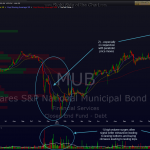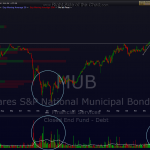MUB is the iShares national muni-bond etf. here’s the last few charts i posted here plus the updated chart showing my target has been hit. the important take-away from this, i believe, is the impact that the bubble de jour that the fed is creating will have on people’s finances, especially that of the millions of pre- and post-retirees out there who depend on fixed income for either stability or living expenses (or both).
take this “safe” muni-bond etf, for example. grandma jenkins, who just plunked in $50k to try and replace the income from her 5% XYZ county municipal bond that came due on jan 30th (date of my first chart below) bought into MUB at the current price that day of $113.26/share for a current yield of 2.90%. yes, that’s about $1,050 per year less than she was receiving from her muni bond that she had for the last 10 yrs but “oh well, what can i do?”. grandma will just have to cut out one of her medications or sell the car and start taking the city bus to and from bingo and the grocery store every week.
here the rub: that ETF is down over 5% since she bought it and unlike an individual bond, there is no guaranteed return of principal. in fact, i’d say the odds are high that she’ll lose even more principal over the next few years as rates have pretty much nowhere but up to go from here. therefore, if she sold today, she will have realized a loss of $2,500. if she continues to hold, that loss will likely grow larger. we have begun to see similar action in other yield producing investments (AGG, LQD) mostly bonds at this point but soon we will see similar flights out of REITs, utility stocks, and other instruments that the fed has forced yield-hungry investors into.
one other thing to consider is that the stock market historically does well when interest rates are falling, as investors abandon the safety of fixed income investments for the higher return potential from riskier assets like stocks and vice versa when rates start moving higher: money moves out of stocks as the returns on fixed income investments increase.




